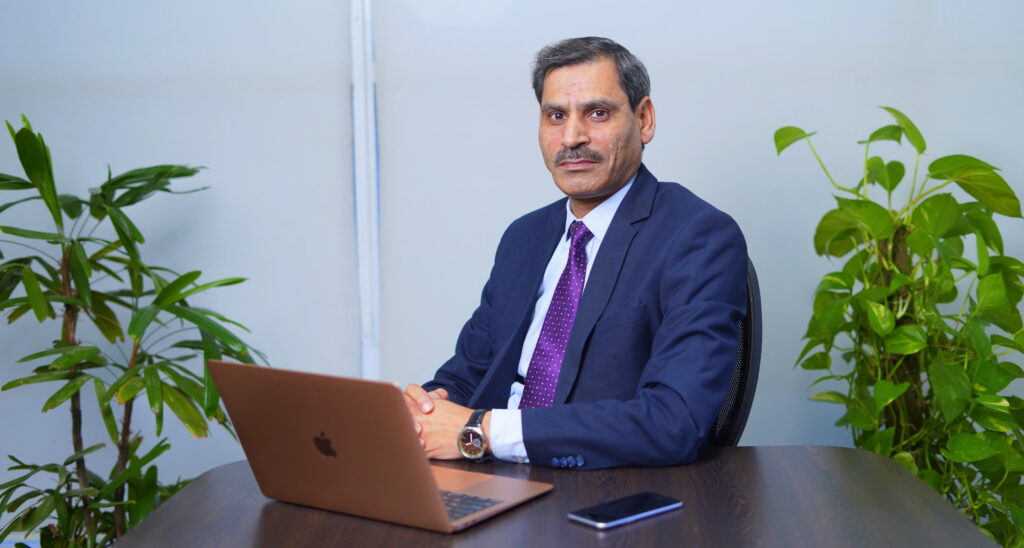Recently, we interacted with Mr. Rajesh Kaushal, Vice President, Delta Electronics India – a leading Taiwan-based Power and Energy management company operating in three business categories: Power Electronics, Automation and Infrastructure. We asked him about 5G initiatives undertaken by Delta, and how 5G is empowering different sectors and industries
![[Exclusive Interview] Find Out How 5G Is Powering Manufacturing, Agriculture, Energy & More Sectors In India](https://trak.in/stories/wp-content/uploads/2023/07/Untitled-design-22.png)
Here are the interview highlights:
Q. How do you evaluate India’s overall progress in rolling out 5G in the country? Please elaborate on the positives, the delays, the hurdles, the ideal milestones that the country should have achieved, etc.
India’s overall progress in rolling out 5G technology has shown both positive aspects and encountered certain delays and hurdles. On the positive side, the government has implemented favorable policies to support 5G deployment, including the National Digital Communications Policy and Spectrum Auctions. This has laid a strong foundation for the development of a robust 5G ecosystem. Collaboration among industry stakeholders, including telecom operators, equipment manufacturers, and research institutions, has fostered innovation and indigenous development of 5G technologies. Additionally, pilot projects and trials have been conducted to test and showcase 5G use cases in various sectors, demonstrating its potential benefits. However, there have been delays and hurdles in the rollout of 5G. Spectrum availability remains a significant challenge, with delays in spectrum allocation and auctions. Adequate spectrum is crucial for the timely deployment of 5G networks. Infrastructure readiness is another hurdle, as substantial investments are required for tower installations, fiber connectivity, and network upgrades. Regulatory considerations related to spectrum pricing, security, and harmonization with global standards also need to be addressed.

Mr. Rajesh Kaushal, Vice President, Delta Electronics India
Ideal milestones for India’s 5G rollout would include timely spectrum allocation, nationwide coverage starting from major cities and expanding to rural areas, successful implementation of industry-specific use cases, development of a robust 5G ecosystem with domestic manufacturing capabilities, and collaboration with international stakeholders and standardization bodies. Achieving these milestones would pave the way for India to emerge as a global leader in 5G technology, driving digital transformation and economic growth while benefiting various sectors of the economy.
Q. How strong is the 5G ecosystem in India? Would it be built upon what the country already has for 4G or is there a need to rebuild or create a new ecosystem?
As a leading provider of 5G solutions, Delta Electronics India is pleased to see the progress that India has made in rolling out the next generation of wireless technology. In just over a year since the first 5G networks were launched, the country has already covered over 600 cities and towns. This is a significant achievement, and it is clear that India is committed to making 5G a reality for its citizens. There have been some delays in the rollout of 5G, but these have been largely due to factors beyond the control of the government or the telecom operators. For example, the global chip shortage has made it difficult to procure the necessary equipment. However, these delays are expected to be temporary, and the government has stated that it is confident that 5G coverage will reach all parts of the country by 2024.
There are a number of hurdles that India will need to overcome in order to fully realize the benefits of 5G. One of the biggest challenges is the lack of 5G-enabled devices. Currently, there are only a handful of 5G smartphones available in India, and the prices of these devices are still relatively high. As the price of 5G devices comes down and more models become available, we expect to see a rapid increase in 5G adoption. Another challenge is the need for investment in 5G infrastructure. In order to provide widespread 5G coverage, telecom operators will need to invest heavily in new towers and base stations. This investment will be expensive, but it is essential if India wants to reap the benefits of 5G.
Despite the challenges, we believe that India is well-positioned to become a global leader in 5G. The country has a young and tech-savvy population, and it is also home to a number of leading technology companies. With the right policies and investments, India can become a major player in the global 5G market. Delta Electronics India is committed to supporting India’s 5G ambitions. We are investing in research and development of 5G solutions, and we are also working with telecom operators to deploy 5G networks across the country. We believe that 5G has the potential to transform India’s economy and society, and we are excited to be a part of this journey.
Q. How would you rate the level of collaboration between telecom operators, equipment manufacturers, regulators, and other stakeholders? Is the country on the right track?
The collaboration between telecom operators, equipment manufacturers, regulators, and other stakeholders in India’s 5G rollout is rated as moderately positive. While there have been collaborative efforts and partnerships, there is still room for improvement. Telecom operators and equipment manufacturers have jointly undertaken initiatives and trials to drive innovation and develop indigenous 5G solutions, showcasing its potential across sectors. Regulators have also created a favorable environment through policy formulation and spectrum allocation. However, there is a need for greater coordination to address challenges like spectrum availability, infrastructure readiness, and regulatory considerations. Closer collaboration among stakeholders will lead to a more efficient 5G rollout. India is on the right track with its focus on 5G adoption, as reflected in government initiatives and regulatory frameworks. While progress has been made, concerted efforts are required for enhanced collaboration. With the right strategies, timely spectrum allocation, infrastructure development, and continuous collaboration, India can ensure a successful and widespread 5G rollout. Continued efforts and stronger coordination among stakeholders are crucial to drive India’s 5G progress and remain on the right track.
Q. What role can research, academia, and indigenous manufacturing play in accelerating and smoothening the 5G pathway in India?
Research, academia, and indigenous manufacturing play crucial roles in accelerating and smoothening the 5G pathway in India. These sectors contribute to technological advancements, skill development, and self-reliance, fostering a robust 5G ecosystem. Research institutions and academia are at the forefront of driving innovation and conducting research on 5G technologies. Their expertise and collaborations with industry stakeholders help in developing cutting-edge solutions, exploring new use cases, and addressing technical challenges. By focusing on research and development, they contribute to the creation of indigenous technologies, patents, and intellectual property rights, thereby strengthening India’s position in the global 5G landscape.
Indigenous manufacturing is instrumental in reducing dependency on imports and promoting domestic production of 5G equipment and devices. It creates opportunities for local employment, fosters technological self-sufficiency, and drives economic growth. By encouraging indigenous manufacturing, India can ensure the availability of cost-effective and customized 5G solutions tailored to the country’s specific requirements. Collaboration between research institutions, academia, and the industry is vital for knowledge exchange, skill enhancement, and technology transfer. It facilitates the training of skilled professionals in 5G technologies and promotes industry-academia partnerships to address the skill gap in the workforce. Such collaborations also lead to the development of industry-driven curricula and research programs that align with the needs of the 5G ecosystem.
Q. How ready is India in terms of infrastructure and regulatory environment to reap the real benefits of 5G? What are the key gaps, and what do the industry and the government need to do to plug them?
India has made significant progress in enhancing its infrastructure readiness for 5G. The government has taken steps to expand telecommunications networks through fiber optic cable deployment and improve mobile broadband coverage. However, there are still gaps in coverage, particularly in rural and remote areas. To bridge these gaps, the government should allocate sufficient spectrum at reasonable prices and streamline regulatory processes and licensing frameworks. IITs (Indian Institutes of Technology) can play a key role in research and development of indigenous 5G technologies, standards, and solutions. Collaboration between IITs, telecom operators, and equipment manufacturers can foster innovation, skill development, and technology transfer.
Open RAN (Radio Access Network) can revolutionize telecom manufacturing in India by promoting interoperability and flexibility in network architecture. This will reduce dependency on a few vendors and unlock opportunities for domestic telecom equipment manufacturing. The Production-Linked Incentive (PLI) scheme launched by the government also plays a significant role in promoting telecom manufacturing in India. Under the PLI scheme, incentives are provided to domestic and global manufacturers to establish or expand their manufacturing capabilities in the country. By leveraging the research capabilities of IITs, embracing Open RAN standards, and capitalizing on the PLI scheme, India can foster local innovation, strengthen its telecom manufacturing capabilities, and accelerate the adoption of 5G technology. Collaboration among industry players, academia, research institutions, and the government is vital in driving knowledge sharing, skill development, and technology advancements, ultimately positioning India at the forefront of the global 5G revolution.
Q. Does the country lack in any way in terms of FTTH, fibre optics, LTE, tower footprint, small cell footprints, spectrum, end-user device readiness, network advancements, etc. in its journey of rolling out 5G? How can the industry and the government address these jointly and at their respective levels?
India is making progress in its journey to roll out 5G, but there are still some areas where the country lacks. One major challenge is the low tower fiberization status, which currently stands at just 35%. This means that a significant number of towers in India do not have fiber optic cables connected to them, which is crucial for 5G to function optimally. To address this, the industry estimates that an investment of Rs. 3 lakh crore is required to fiberize all towers in the country. Additionally, India needs to increase the number of telecom towers by deploying an additional 12 lakh towers to become 5G-ready. Another hurdle is the need for more spectrum allocation for 5G services, as the existing auctions have not been sufficient to meet the demand.
Furthermore, the availability of end-user devices that support 5G is limited in India at present. However, the industry expects this to improve in the future with a broader range of 5G-enabled devices becoming available. To overcome these challenges, the industry and the government can collaborate on various fronts. Firstly, investing in tower fiberization would significantly enhance the performance of 5G networks. Joint efforts from the industry and the government to invest in tower fiberization would ensure that more towers have fiber optic connectivity. Moreover, deploying more telecom towers across the country would increase the coverage of 5G networks, making the services accessible to a larger population. Additionally, allocating more spectrum for 5G services is crucial to improving network performance. The government can take steps to allocate additional spectrum to meet the growing demand for 5G. Encouraging the development of 5G-enabled devices in collaboration with the industry would also contribute to making these devices more widely available in India.
By addressing these challenges and taking the suggested steps, the industry and the government can ensure that India is well-prepared for the 5G revolution. It will not only enhance connectivity and communication but also position India as a leader in the global 5G landscape.
Q. Is it too early or late to talk about AI, privacy, security, and data protection challenges in the 5G context?
It is neither too early nor too late to discuss AI, privacy, security, and data protection challenges in the context of 5G. These topics are highly relevant and should be addressed throughout the development and deployment of 5G technology. As 5G networks enable a massive increase in data transfer speeds and connectivity, concerns regarding the use of AI, privacy breaches, security vulnerabilities, and data protection become even more critical. It is essential to have proactive discussions, establish robust frameworks, and implement necessary safeguards to ensure that the benefits of 5G are balanced with the protection of individual privacy, security, and data integrity. By addressing these challenges early on, we can help create a secure and trusted 5G ecosystem that harnesses the potential of AI while safeguarding user rights and maintaining data privacy and security.
Q. What has the company done in driving 5G rollout, adoption, and innovation in India?
Delta Electronics has played a significant role in driving the 5G rollout, adoption, and innovation in India. As a leading provider of power and thermal management solutions, the company has actively contributed to the development of the 5G ecosystem. Delta has collaborated with telecom operators, equipment manufacturers, and system integrators to deploy cutting-edge infrastructure required for 5G networks. We have supplied advanced power supply systems, cooling solutions, and energy-efficient technologies that are crucial for the successful implementation of 5G. Delta’s solutions have not only ensured reliable and uninterrupted power supply but have also optimized energy consumption, reducing the carbon footprint of 5G networks. Furthermore, Delta has been at the forefront of innovation by investing in research and development of 5G-related technologies. We have introduced innovative products and solutions such as small cell power systems, intelligent energy management systems, and efficient cooling solutions tailored for 5G applications. Delta Electronics India’s relentless efforts have significantly contributed to the progress of 5G in India, enabling faster and more reliable connectivity, and paving the way for a digitally empowered nation.
Q. Please share 5G use cases demonstrated by your company. Also, share use cases or templates from other countries that India can refer to.
As Delta Electronics India, we have actively participated in showcasing innovative 5G use cases across various sectors. One of the notable use cases demonstrated by our company is the implementation of 5G in the manufacturing industry. By harnessing the power of 5G, we have facilitated real-time monitoring and control of industrial processes, enabling predictive maintenance, improved productivity, and efficient resource management. This technology has the potential to revolutionize India’s manufacturing sector, making it more competitive on a global scale.
Furthermore, Delta Electronics India has demonstrated the application of 5G in the energy sector. With the deployment of 5G-enabled smart grids, we have showcased the ability to monitor and manage energy distribution in real-time, optimize power consumption, and enhance grid resilience. This technology empowers consumers to make informed energy choices and promotes sustainability by enabling the integration of renewable energy sources into the grid.
In terms of international use cases, India can refer to the advancements made in countries such as the United States, South Korea, Germany, and the United Kingdom. The United States has demonstrated successful 5G use cases in areas like autonomous vehicles, precision agriculture, and smart cities. South Korea has focused on implementing 5G in industries such as manufacturing, logistics, and entertainment. Germany has showcased the use of 5G in industrial automation, healthcare, and transportation. Lastly, the United Kingdom has made strides in utilizing 5G for augmented reality applications, smart tourism, and remote education. By studying these international use cases, India can gain valuable insights and best practices to tailor 5G implementations to its specific needs and requirements, driving innovation and economic growth across various sectors in the country.









